

TPS Teachers Network. Create Maps. Roadside America. City Guesser - Can you guess what city you're in? WorldCover. Celebrate Geography Awareness Week. Life on Minimum Wage - A Personal Economics Simulation Game. Almost twelve years ago I published a Google Document that outlines a personal economics simulation that I conducted in my classroom.

For many years after that it was the most-requested Google Doc that I published. Then for the last few years I haven't had any requests for it. In fact, I forgot that I had even published it. That changed this week when out of the blue I got a few requests for it. You can get a copy of my simulation, Life on Minimum Wageright here. The purpose of Life on Minimum Wage is for students to recognize how difficult it is to save money when your only job(s) pay minimum wage without benefits. Copy of Life on Minimum Wage. Bill of Rights in Action - Constitutional Rights Foundation. SPECIAL NOTICE: Starting in fall 2020, we plan to publish two issues of the quarterly Bill of Rights in Action in electronic format only and two issues in print and electronic format.
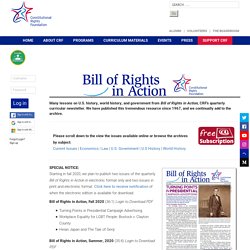
Click here to receive notification of when the electronic edition is available for download. What Should the U.S. Do About North Korea’s Nuclear Weapons? The Great Sioux War: Land, Gold, and a Broken TreatyThe Dispute Over the South China Sea Democracy in the Balance, Fall2017 (33:1) Login to Download PDF How Democratic Was Athens? Historical Thinking Matters: Teacher Educators - Lessons. Teacher Educator Lesson: Opening Up the Textbook (OUT) Overview: In this lesson, teacher candidates first engage in a demonstration lesson where they consider the traditional textbook story about Rosa Parks in relation to two primary documents that question and contradict that narrative.
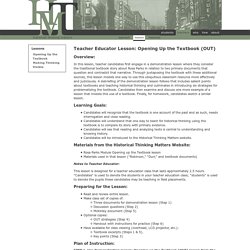
Through juxtaposing the textbook with these additional sources, this lesson models one way to use this ubiquitous classroom resource more effectively and judiciously. Teachinghistory.org. Why do it?
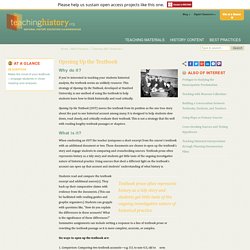
If you’re interested in teaching your students historical analysis, the textbook seems an unlikely resource. This strategy of Opening Up the Textbook, developed at Stanford University, is one method of using the textbook to help students learn how to think historically and read critically. Opening Up the Textbook (OUT) moves the textbook from its position as the one true story about the past to one historical account among many. It is designed to help students slow down, read closely, and critically evaluate their textbook. Home.
Cronobook. DocsTeach. TPS Teachers Network Albums for Classroom Use. Teaching ideas from the creator of this album Thanks to some fabulous TPS consortium members, I learned about Sanborn maps for the first time--so cool!

Teaching with Ken Burns in the Classroom. For more than 40 years, we’ve been privileged to tour history through the rich and creative lens of Ken Burns and his collaborators.
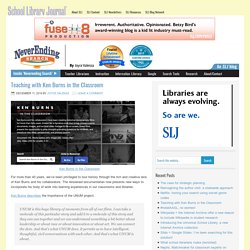
The renowned documentarian now presents new ways to incorporate his body of work into learning experiences in our classrooms and libraries. Ken Burns describes the importance of the UNUM project: Creating Active Citizens: Ideas for Civic Engagement Lessons. Oregon teachers set aside the first Friday in December to focus on civic engagement lessons and professional development.
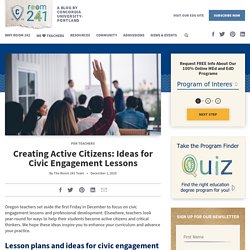
Elsewhere, teachers look year-round for ways to help their students become active citizens and critical thinkers. We hope these ideas inspire you to enhance your curriculum and advance your practice. Why Instructional Design Must Focus on Learning Outcomes, Not Learning Activities. It’s no secret that kids learn better when teachers provide learning activities that keep them engaged. Teachers work tirelessly to plan engaging lessons that capture and keep the interests of their students, thereby making content more accessible. However, teachers continue to feel the daunting pressure to compete for their students’ attention amidst the ever-evolving and rapidly-hanging mass media, social media, and entertainment industry, as these elements do a stellar job of keeping students highly engaged outside of the classroom.
Eagle Eye Citizen – Roy Rosenzweig Center for History and New Media. Digital Scholarship Lab. Bringing Congress to the Classroom. Skip navigation Library of Congress Law Library of Congress Suggestions enabled.
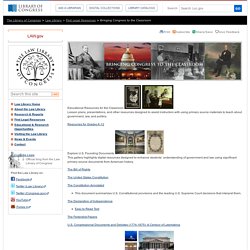
The Library of Congress > Law Library > Find Legal Resources > Bringing Congress to the Classroom. Bunkhistory.org. C-Span Classroom: Free video-based materials for social studies teachers. The Valley of the Shadow: Two Communities in the American Civil War.
Journal of the First Voyage of Columbus. ECHOES OF THE GREAT WAR - A SERIES OF WEBINARS: TPS Teachers Network. "A Perfect Inferno" - Echoes of the Great War: American Experiences of World War I. Abbe Museum: One mission, two locations - Inspiring new learning about the Wabanaki Nations with every visit. Historical Agricultural News. First landing of Columbus on the shores of the New World: At San Salvador, W.I., Oct. 12th 1492 : TPS Teachers Network. Raising Engineering Awareness through the Conduit of History. Eagle-Eye Citizen: Solve and create American history and civics challenges to explore Library of Congress primary sources — and look closer. Zoom In: Empowering students to think deeply and write critically about pivotal moments in US history. Common Lit: Free Fiction & Nonfiction Literacy Resources, Curriculum, & Assessment Materials for Middle & High School English Language Arts.
National Archives: Educator Resources. Newsela Text Sets for Social Studies. National Archives: Teaching With Documents. When we ask students to work with and learn from primary sources, we transform them into historians. Rather than passively receiving information from a teacher or textbook, students engage in the activities of historians — making sense of the stories, events and ideas of the past through document analysis. Document Analysis Document analysis is the first step in working with primary sources. Teach your students to think through primary source documents for contextual understanding and to extract information to make informed judgments. Learn more and access our analysis worksheets for photographs, written documents, artifacts, posters, maps, cartoons, videos, and sound recordings. DocsTeach Explore our online tool for teaching with documents from the National Archives.
You can borrow from an ever-expanding collection of document-based activities created by the National Archives, and teachers around the world. Lesson Plans. Beyond the Bubble: Assessing 21st-century Skills with LOC documents. The American Civil War. Reading Like a Historian: Contextualization. Notable Social Studies Trade Books for Young People. DocsTeach: Bring History to Life. Social Studies Central. Featured Product: Evidence Analysis Window Frame We often ask students to analyze evidence and to think historically.

But these are skills that often need scaffolding. So we’ve printed historical thinking questions along the edges of heavy duty plastic sheets that your students place on top of photos, documents, maps, political cartoons, and other pieces of evidence. Kids then use dry erase or overhead pens to connect historical thinking questions with evidence found in the document. This Evidence Analysis Window Frame combines critical thinking with a visual, tactile activity that is great for encouraging historical thinking, developing analysis abilities, and supporting literacy skills.
This is the one sided version of the Window Frame – printed on 10 mil erasable plastic. Reading Like A Historian. The Reading Like a Historian curriculum engages students in historical inquiry.
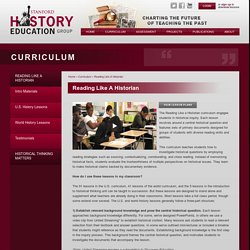
Each lesson revolves around a central historical question and features sets of primary documents designed for groups of students with diverse reading skills and abilities. This curriculum teaches students how to investigate historical questions by employing reading strategies such as sourcing, contextualizing, corroborating, and close reading. Geography Awareness Week 2017: The Geography of Civil Rights Movements. This week, Geography Awareness Week celebrates 30 years of geo goodness. Established in 1987, the week is designed to promote geography and highlight the relevance of a geographic education in preparing citizens to understand and debate pressing social and environmental issues and problems. This year’s theme focuses on the Geography of Civil Rights Movements. A recent American Association of Geographers press release suggests that a “civil rights-themed Geography Awareness Week can be an important moment, especially during these turbulent political times, to come to terms with the nation’s unreconciled legacies of oppression and domination.”
The AAG goes on: Teaching with the Library of Congress. Stop-action photography has become an integral part of our lives. It allows us to watch the beauty of a dancer, the grace of an athlete or the motion of an animal one frame at a time. It is hard to believe that until Edweard Muybridge began his study of animal locomotion with photography in the late 19th century, we were limited to only what the eye could see or what was in a single photograph. In celebration of Muybridge’s birthday, the Library of Congress has uploaded a number of Muybridge’s Animal Locomotion images from its collections into Flickr. The horse in motion, illus. by Muybridge. “Sallie Gardner,” owned by Leland Stanford, running at a 1:40 gait over the Palo Alto track, 19 June 1878: 2 frames showing diagram of foot movements.